Jul 2, 2018 | coins, commemorative, dollar, legislative, US Mint
Sometimes watching specific legislation to make its way through Congress is like watching paint dry. We know the paint will eventually dry but it takes a lot longer than we have time to wait. With the exception of bills that are proposing useful things like eliminating the paper dollar for a coin, there is no point to check daily.
But that is what I do. I wrote a program to download the bill information produced by the Government Printing Office on behalf of the Congress and store it in a database so that it can be reported here. This process does not become interesting until something happens.
The last two weeks in June looks like it was the equivalent of a wild ride. First, the American Innovation $1 Coin Act (H.R. 770) appeared on the agenda in the House of Representatives where the only “debate” was Rep. Jim Himes (D-CT), the bill’s sponsor, and the day’s floor manager, Rep. Sean Duffy (R-OH) speaking in favor of passage. Then it followed the regular course of passage by the House, passage by the Senate with a change, followed by the House agreeing with the amendment. Next month it should be signed into law by the President.
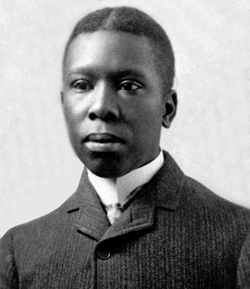
Paul Laurence Dunbar, circa 1890
Paul Laurence Dunbar (1872-1906) was an American poet, novelist, and playwright. Dunbar was very popular in his day whose work was known for its colorful language and conversational tone that made his work seem lyrical. Dunbar, who was born in Dayton, Ohio as a child of former slaves, was famous for writing in the “Negro dialect” that was associated with the antebellum south.
Dunbar had briefly worked at the Library of Congress before resigning to concentrate on his writing. His home in the LeDroit Park neighborhood of Washington, DC still stands today. In 1904 he returned to Dayton to be with his ailing mother but ended up contracting tuberculosis and dying in 1906.

Carson City Mint (1866)
The Carson City Mint opened in 1870 primarily in response to the Comstock Lode. It started as an Assay Office in 1963 but did not gain Mint status until 1870. It was in operation from 1870-1885 and 1889-1893. It is the only branch of the U.S. Mint to have used a two-letter mint mark.
Today, the building is a branch of the Nevada State Museum.
Since the text of both bills has not been published, details of the programs are unknows except it is safe to assume that the Carson City 150th Anniversary commemorative coin program will occur in 2020.
H.R. 770: American Innovation $1 Coin Act
Summary: (Sec. 2) This bill directs the Department of the Treasury, over a 14-year period beginning in 2019, to mint and issue “American Innovation” $1 coins commemorating innovation and innovators from each state, each U.S. territory, and the District of Columbia. Treasury shall issue four coins per year, in alphabetical order by jurisdiction, until a coin has been issued for each jurisdiction. Treasury may mint and issue a $1 coin in 2018 to introduce the series. Neither the bust of any person nor the portrait of any living person may be included in the design of the coins.The bill instructs Interior to continue to mint and issue $1 coins honoring Native Americans and their contributions.
Motion to reconsider laid on the table Agreed to without objection. — Jun 27, 2018
On motion that the House agree to the Senate amendment Agreed to without objection. (text as House agreed to Senate amendment: CR H5786-5787) — Jun 27, 2018
Mr. Hensarling asked unanimous consent to take from the Speaker’s table and agree to the Senate amendment. — Jun 27, 2018
Message on Senate action sent to the House. — Jun 21, 2018
Passed Senate with an amendment by Voice Vote. — Jun 20, 2018
Measure laid before Senate by unanimous consent. — Jun 20, 2018
Senate Committee on Banking, Housing, and Urban Affairs discharged by Unanimous Consent. — Jun 20, 2018
Received in the Senate and Read twice and referred to the Committee on Banking, Housing, and Urban Affairs. — Jan 17, 2018
Motion to reconsider laid on the table Agreed to without objection. — Jan 16, 2018
On motion to suspend the rules and pass the bill, as amended Agreed to by voice vote. — Jan 16, 2018
DEBATE – The House proceeded with forty minutes of debate on H.R. 770. — Jan 16, 2018
Considered under suspension of the rules. — Jan 16, 2018
Mr. Duffy moved to suspend the rules and pass the bill, as amended. — Jan 16, 2018
Referred to the House Committee on Financial Services. — Jan 31, 2017
H.R. 6214: To require the Secretary of the Treasury to mint commemorative coins in recognition of Paul Laurence Dunbar.
Referred to the House Committee on Financial Services. — Jun 25, 2018
H.R. 6221: To require the Secretary of the Treasury to mint coins in commemoration of the Carson City Mint 150th anniversary, and for other purposes.
Referred to the House Committee on Financial Services. — Jun 26, 2018
All images courtesy of Wikimedia Commons.
Jun 28, 2018 | coins, dollar, legislative, US Mint
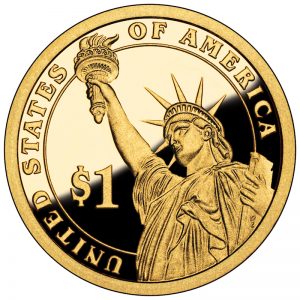
Presidential $1 Coin Common Reverse
The next step is that the bill is engrossed, which means that it will be printed in its final form and signed by the Speaker of the House, Paul Ryan (R-WI), and the President Pro Tempore of the senate, Orrin Hatch (R-UT), certifying that the printed bill has been approved by both chambers of commerce.
Once signed, the bill is sent to the White House for the President’s signature.
If this bill was not on your radar, it requires the coins use the same Manganese-Brass composition as all dollar coins struck since 2000 with the edge lettering consisting of the year, mintmark, and the national motto E PLURIBUS UNUM. The obverse will be “a likeness of the Statue of Liberty extending to the rim of the coin and large enough to provide a dramatic representation of Liberty.” The reverse will be emblematic of an innovation, innovator, or a group of innovators significant to that state or territory.
If the president signs this bill, and there is no reason why he would veto this biil, then the program will begin in 2019.
Jun 22, 2018 | coins, dollar, legislative
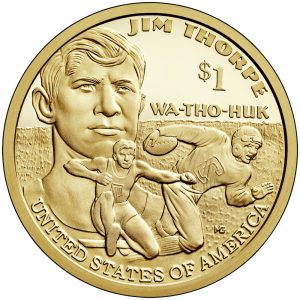
2018 Native American $1 Coin featuring Jim Thorpe
On Wednesday, June 20, the Senate passed the American Innovation $1 Coin Act (H.R. 770) by a unanimous voice vote. However, since the bill was amended by the Senate, the bill has to go back to the House of Representatives to approve the amendment or it will have to go to a conference committee and back to each chamber for a vote.
The amendment changes the order of issuance from alphabetical order to the order that the state entered the union followed by the District of Columbia and the territories. This was the same order uses for the 50 State Quarters program.
If the House approves the amendment, it is sent to the President for his signature.
If signed, the 14-year program will honor “American innovation and significant innovation and pioneering efforts of individuals or groups from each of the 50 States, the District of Columbia, and the United States territories.” Four dollar coins will be issued each year and not circulate alongside the Native American Dollar coin.
The bill requires the coins use the same Manganese-Brass composition as all dollar coins struck since 2000 with the edge lettering consisting of the year, mintmark, and the national motto E PLURIBUS UNUM. The obverse will be “a likeness of the Statue of Liberty extending to the rim of the coin and large enough to provide a dramatic representation of Liberty.” The reverse will be emblematic of an innovation, innovator, or a group of innovators significant to that state or territory.
I wish I could get excited about this series but it will not even raise an eyebrow as long as it does not circulate. And the only way it will circulate is if Congress votes to eliminate the one-dollar Federal Reserve Note. Unfortunately, the likelihood of that happening is slim-to-none and Slim just left town!
Jun 1, 2018 | coin design, coins, gold, legislative
Although it is not really a numismatic-related bill, the Saint-Gaudens National Historical Park Redesignation Act appears to be on track for passage in the Senate.
Essentially, the bill redesignates the Saint-Gaudens National Historic Site, Augustus Saint-Gaudens’ former home in New Hampshire, as the “Saint-Gaudens National Historical Park.” The change is significant in that it changes the funding for the staffing and maintenance of the site. It also will keep the site accessible for tourism.
Augustus Saint-Gaudens is known as the artist who co-conspired with President Theodore Roosevelt in his “pet crime” to redesign United States coinage. Before his death in 1907, Saint-Gaudens provided the design for the $20 Double Eagle and $10 Eagle gold coinage.
Saint-Gaudens’ legacy did continue after his death by his students Adolph A. Weinman, designer of the Walking Liberty half-dollar and Mercury dime, and James Earle Fraser, designer of the Buffalo Nickel.
S. 2863: National Law Enforcement Museum Commemorative Coin Act
Read twice and referred to the Committee on Banking, Housing, and Urban Affairs. — May 16, 2018
H.R. 965: Saint-Gaudens National Historical Park Redesignation Act
Summary: (Sec. 2) This bill redesignates the Saint-Gaudens National Historic Site, in New Hampshire, as the "Saint-Gaudens National Historical Park."
Referred to the House Committee on Natural Resources. — Feb 7, 2017
Placed on the Union Calendar, Calendar No. 197. — Aug 25, 2017
Reported (Amended) by the Committee on Natural Resources. H. Rept. 115-277. — Aug 25, 2017
Mr. Thompson (PA) moved to suspend the rules and pass the bill, as amended. — Oct 2, 2017
Considered under suspension of the rules. — Oct 2, 2017
DEBATE – The House proceeded with forty minutes of debate on H.R. 965. — Oct 2, 2017
At the conclusion of debate, the Yeas and Nays were demanded and ordered. Pursuant to the provisions of clause 8, rule XX, the Chair announced that further proceedings on the motion would be postponed. — Oct 2, 2017
Considered as unfinished business. — Oct 2, 2017
On motion to suspend the rules and pass the bill, as amended Agreed to by the Yeas and Nays: (2/3 required): 401 – 0 (Roll no. 545). — Oct 2, 2017
Motion to reconsider laid on the table Agreed to without objection. — Oct 2, 2017
Received in the Senate and Read twice and referred to the Committee on Energy and Natural Resources. — Oct 3, 2017
Committee on Energy and Natural Resources. Ordered to be reported without amendment favorably. — May 17, 2018
May 1, 2018 | coins, commemorative, dollar, legislative
 The first of the month is when I usually report about the introduction or progress of numismatic-related legislation in congress for the previous month. For April 2018, there is nothing to report.
The first of the month is when I usually report about the introduction or progress of numismatic-related legislation in congress for the previous month. For April 2018, there is nothing to report.
Thus far, the 115th Congress passed The American Legion 100th Anniversary Commemorative Coin Act (Pub. L. 115-68) which allows for a gold $5, silver dollar, and clad half-dollar coins to commemorate the American Legion in 2019.
There have been no authorizing laws passed for commemoratives after 2019.
Two bills have passed the House of Representatives and are waiting in committees in the Senate for action:
- The Naismith Memorial Basketball Hall of Fame Commemorative Coin Act (H.R. 1235) would allow the minting of q gold $5, silver dollar, and clad half-dollar coins in honor of the 60th anniversary of the Hall of Fame in Springfield, Massachusetts.
- The American Innovation $1 Coin Act (H.R. 770) would be a 14-year $1 coin program that would issue coins commemorating innovation and innovators representing each state, the District of Columbia, and U.S. territories.
Just because these bills passed in the House does not mean the Senate will do anything about them. Both can die in committee without any consideration.
So that the record is complete, here are the numismatic-related bills introduced in the House of Representatives waiting in committee:
- Muhammad Ali Commemorative Coin Act (H.R. 579)
- Duty First Act (H.R. 1582)
- National Purple Heart Hall of Honor Commemorative Coin Act (H.R. 1683)
- Cents and Sensibility Act (H.R. 2067)
- Christa McAuliffe Commemorative Coin Act of 2017 (H.R. 2256)
- Currency Optimization, Innovation, and National Savings Act of 2017 (H.R. 2299)
- United States Coast Guard Commemorative Coin Act of 2017 (H.R. 2317)
- President John F. Kennedy Commemorative Coin Act (H.R. 3274)
- 75th Anniversary of the End of World War II Commemorative Coin Act (H.R. 4044)
- Plymouth 400th Anniversary Commemorative Coin Act of 2017 (H.R. 4539)
- National Law Enforcement Museum Commemorative Coin Act (H.R. 4732)
- Women’s History and Nineteenth Amendment Centennial Quarter Dollar Coin Program Act (H.R. 5308)
- To define the dollar as a fixed weight of gold. (H.R. 5404)
Not to be outdone, here is the list for the Senate:
- Saint-Gaudens National Historical Park Redesignation Act (S. 312)
- Currency Optimization, Innovation, and National Savings Act of 2017 (S. 759)
- Duty First Act (S. 921)
- United States Coast Guard Commemorative Coin Act of 2017 (S. 1021)
- American Innovation $1 Coin Act (S. 1326)
- Naismith Memorial Basketball Hall of Fame Commemorative Coin Act (S. 1503)
- President John F. Kennedy Commemorative Coin Act (S. 1568)
- Muhammad Ali Commemorative Coin Act (S. 166)
- 75th Anniversary of the End of World War II Commemorative Coin Act (S. 1718)
- Plymouth 400th Anniversary Commemorative Coin Act of 2017 (S. 2189)
- American Innovation $1 Coin Act (S. 2399)
Apr 2, 2018 | coins, commentary, legislative
 While Congress delves into the abyss of their usual folly, the numismatic industry went almost hysterical at the bill introduced by Rep. Barbara Lee (D-CA) to create yet another quarters series to begin in 2021.
While Congress delves into the abyss of their usual folly, the numismatic industry went almost hysterical at the bill introduced by Rep. Barbara Lee (D-CA) to create yet another quarters series to begin in 2021.
Not considering the topic, there is a fatigue over changing quarter designs. The 50 State Quarter Series was a success while economic times were good and the states were taking their responsibility for designing the quarters serious. Some states really missed out on good design and good choices that there are some quarters that should be melted and spared from our change.
And while there have been wonderful designs for the America the Beautiful quarters, the response has been anywhere from underwhelming to non-existent. Few people know the series exists and when it is pointed out to them there is a collective shrug of acknowledgment.
The other problem goes to the mouth-breathing aspect of the coverage in that the bill was just introduced into the House of Representatives, it is not the law. It is a long way from a bill being a law. If you forgot the process you can always rewatch the old Schoolhouse Rock video I’m Just a Bill.
For the record, I have no problem with honoring the Nineteenth Amendment and the women who made it possible. I would also have no problem with a coin program honoring the Fourteenth Amendment and the people involved in Civil Rights. This country can use a dose of education and if it can be done using coinage, then maybe I might reconsider my stance on the ever-changing coin designs.
At least David Ryder’s nomination was confirmed!
PN1355: David J. Ryder — Department of the Treasury
Date Received from President: January 8, 2018
Summary: David J. Ryder, of New Jersey, to be Director of the Mint for a term of five years, vice Edmund C. Moy, resigned.
Received in the Senate and referred to the Committee on Banking, Housing, and Urban Affairs. — Jan 8, 2018
Committee on Banking, Housing, and Urban Affairs. Ordered to be reported favorably. — Jan 17, 2018
Reported by Senator Crapo, Committee on Banking, Housing, and Urban Affairs, without printed report. — Jan 17, 2018
Placed on Senate Executive Calendar. Calendar No. 596. Subject to nominee’s commitment to respond to requests to appear and testify before any duly constituted committee of the Senate. — Jan 17, 2018
Considered by Senate. — Mar 21, 2018
Confirmed by the Senate by Voice Vote. — Mar 21, 2018
H.R. 5308: Women’s History and Nineteenth Amendment Centennial Quarter Dollar Coin Program Act
Referred to the House Committee on Financial Services. — Mar 15, 2018
Mar 22, 2018 | legislative, news, US Mint

David J. Ryder, 39th Director of the U.S. Mint
As the Senate was processing the nominations on the Senate Executive Calendar, Ryder’s name rose to the top of the list. When the clerk read the nomination and asked for commentary from the floor, the only statement was from Cory Booker (D-NJ). It is customary that a senator from the nominee’s home state to say something in support the nominee. Since there was no objection from the floor, the Senate moved to suspend the rules and pass the nomination by voice vote.
Previously, Sen. Chuck Grassley (R-IA) threatened to block the nomination because he felt that the Department of the Treasury did not respond to inquiries to his satisfaction. When it came time to follow through with the threat, Grassley was not even in the Senate chamber during the vote.
There was no comment offered by Grassley’s office.
After 2,629 days or 7 years, 2 months, and 13 days, our long nightmare is over. The U.S. Mint now has a permanent director!
Good luck Director Ryder.
PN1355: David J. Ryder — Department of the Treasury
Date Received from President: January 8, 2018
Summary: David J. Ryder, of New Jersey, to be Director of the Mint for a term of five years, vice Edmund C. Moy, resigned.
Received in the Senate and referred to the Committee on Banking, Housing, and Urban Affairs. — Jan 8, 2018
Committee on Banking, Housing, and Urban Affairs. Ordered to be reported favorably. — Jan 17, 2018
Reported by Senator Crapo, Committee on Banking, Housing, and Urban Affairs, without printed report. — Jan 17, 2018
Placed on Senate Executive Calendar. Calendar No. 596. Subject to nominee’s commitment to respond to requests to appear and testify before any duly constituted committee of the Senate. — Jan 17, 2018
Considered by Senate. — Mar 21, 2018
Confirmed by the Senate by Voice Vote. — Mar 21, 2018
Mar 22, 2018 | commentary, legislative, US Mint
NOTE: This was written and queued for posting prior to the confirmation of David Ryder to become the 39th Director of the U.S. Mint.
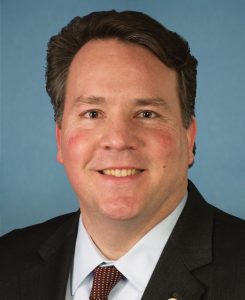
Today’s “Dummy of the Day Award” goes to Rep. Alex Mooney (R-WV) (Official House of Representatives Photo)
In October, Mooney and Rep. Frank Lucas (R-OK) sent a letter to the U.S. Mint asking about what is being done to protect the integrity of U.S. coinage from counterfeiting. The letter contained a gold-plated tungsten American Gold Eagle coin. It was sent after the testimony of David Ryder during his confirmation hearing.
The letter was addressed to Acting Deputy Director David Moti (sic) and Randolph D. Alles, Director of the U.S. Secret Service.
The letter sent by Mooney and Lucas was sent to the U.S. Mint that was run by its fourth non-appointed, interim director since the resignation of Edmund Moy in January 2011. While the interim directors have the same power as political appointees, it is customary that the interim directors maintain the status quo until the Senate approves the president’s nomination.
The U.S. Mint’s response was written under the signatory of Acting Deputy Director David Motl. Motl, Motl’s response to the representative’s inquiry read exactly what can be expected from an interim appointee warming the seat. Basically, the letter said that the U.S. Mint is doing its job as defined by the law and the Acting Deputy Director is working to keep the agency going until a regular director can be approved.
Of course, these representatives did not like this response. They want the U.S. Mint to do something and even gave suggestions. There are two problems with the response that reads like an advertisement for a commercial service. First, if these representatives understood the division of responsibilities, the agency responsible for protecting the integrity of the money supply is the United State Secret Service. The U.S. Mint is the manufacturer of the money, the U.S. Secret Service is the police force that is responsible for protecting the money. One would think that members of Congress who have access to staff and a full-time research department would understand the roles of the various agencies.
Secondly, what would they want an acting director to do? If the acting director is there to make sure the bureau functions until a new director is appointed, then figure out why the U.S. Mint does not have a permanent director? If Mooney does not like the answer then why not take a walk to the other side of the capital and ask Sen. Chuck Grassley (R-IA) why he is throwing a hissy fit and holding up the nomination of a qualified candidate that could legally answer the questions.

David Croft, Acting Deputy Director of the U.S. Mint since 1-Feb-18 (U.S. Mint Photo)
To add to the fun, the U.S. Mint has a new Acting Deputy Director. Because there is a limited amount of time that a government employee can serve in an “acting” role for an appointed position, David M. Croft has been appointed to the posting as of February 1, 2018. Prior to his appointment as Acting Deputy Director, Croft was the Mint’s Associate Director of Manufacturing. Croft becomes the fifth non-appointed “acting” director since Moy’s resignation.
If there are members of Congress that are not happy with the way the U.S. Mint is being run, they need to work out the problems which they are responsible. Mooney and Lucas should take the U.S. Mint leadership issue up with Grassley. Otherwise, they are doing nothing more than spitting into the wind.
Mar 17, 2018 | coins, commemorative, legislative, quarter
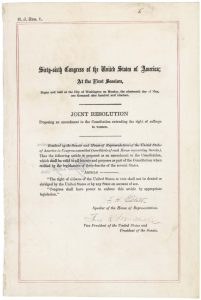
Nineteenth Amendment
The excitement wore off when I saw the bill that was introduced.
Rep. Barbara Lee (D-CA) introduced H.R. 5308 with the initial title of To amend title 31, United States Code, to require the Secretary of the Treasury to mint and issue quarter dollars in commemoration of the Nineteenth Amendment, and for other purposes.
The text of the bill is not available, yet.
The Nineteenth Amendment granted women the right to vote. It was the culmination of the women’s suffrage movement. To amend the constitution, it passed the House of Representatives on May 21, 1919, the Senate on June 4, 1919, then by 36 of the 48 states on August 18, 1920.
How do you create a design to commemorate the Nineteenth Amendment? Will there be one quarter per state? If so, what would be on Maryland’s quarter? Maryland rejected the amendment in 1920, the legislature ratified it in 1941, but the vote was not certified until 1958.
Then there is Mississippi that rejected the amendment in 1920 but passed it in 1984 becoming the 48th and last state to ratify the amendment (Alaska and Hawaii were not admitted to the union at the time and are ineligible to vote on the amendment).
While it is appropriate to celebrate the 100th anniversary of Women’s Suffrage, maybe it should be a commemorative coin with the proceeds going to an organization like the League of Women Voters.
H.R. 5308: To amend title 31, United States Code, to require the Secretary of the Treasury to mint and issue quarter dollars in commemoration of the Nineteenth Amendment, and for other purposes.
Referred to the House Committee on Financial Services. — Mar 15, 2018
Mar 1, 2018 | coins, dollar, legislative
 I really want to say something pithy in this month’s legislative update, but nothing comes to mind. It is a situation where there is both a lot and a little going on. There is a lot of talk coming from Capitol Hill but there is little else. The number of bills and resolutions have reduced.
I really want to say something pithy in this month’s legislative update, but nothing comes to mind. It is a situation where there is both a lot and a little going on. There is a lot of talk coming from Capitol Hill but there is little else. The number of bills and resolutions have reduced.
To judge the activity of Congress, I use a few sites to send alerts when one of my senators of the representative of my congressional district does something that registers legislatively. Most of the alerts are for votes with the occasional introduction of a bill or being added as a co-sponsor to other bills. In my unscientific view of what these people have been doing since the opening of the second session of the 115th Congress, the answer appears to be “not much.”
Sen. Chris Murphy (D-CT) did cause a little numismatic stir when he introduced the American Innovation $1 Coin Act. Murphy wants to add a $1 coin for each state, territory, and the District of Columbia to honor a significant innovation, an innovator, or a group of innovators. For example, Tennessee could consider honoring the work in Oak Ridge; Florida could consider honoring Katherine Johnson, Dorothy Vaughan, and Mary Jackson; while New Jersey would likely honor Thomas Edison.
Even if it is a good idea, the program will be a failure as long as Congress does nothing to ensure dollar coins are circulated. The only way to ensure dollar coins circulate is to stop issuing the one-dollar note. Given that Congress has a hard time passing budget and spending bills, I doubt they would do anything to change the monetary system, regardless of the savings that have been projected.
On a lighter note, David Ryder’s nomination to become the next director of the U.S. Mint is still on hold while Chuck Grassley (R-IA) pouts from his Senate office.
S. 2399: American Innovation $1 Coin Act
Read twice and referred to the Committee on Banking, Housing, and Urban Affairs. — Feb 7, 2018





 The first of the month is when I usually report about the introduction or progress of numismatic-related legislation in congress for the previous month. For April 2018, there is nothing to report.
The first of the month is when I usually report about the introduction or progress of numismatic-related legislation in congress for the previous month. For April 2018, there is nothing to report.



